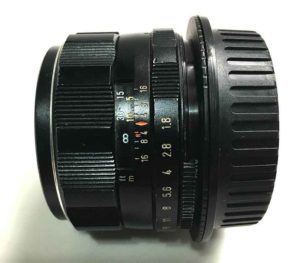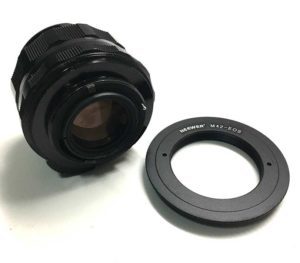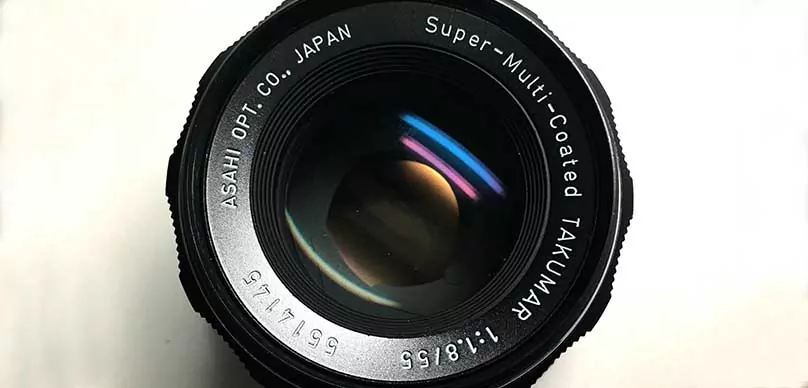Oh the Super Takumar 55mm F1.8, how I love thee. Seriously, I purchased this lens because of its legendary sharpness and the wonderful colors it renders. The Super Takumar 55mm F1.8 produces some amazing images. Even wide open you’ll not only get a usable image but a pretty one as well.
Using this on a crop sensor and you’ll get an 82.5mm, which is still very nice. The lens was originally produced for the Pentax Spotmatic and is by far the most affordable lens in the Super Takumar 55mm line of lenses. Let’s get into the particulars.
EXPOSURE
Many vintage lenses have an issue shooting wide open but not this one. When I shot wide open I was expecting a soft, dream-like image but nope it held up pretty well and the corners were sharp as well. Of course stopping down to F2.8/4 and you get a pin sharp image that is unheard of for the price.

CHARACTER
The Super Takumar 55mm F1.8 has very nice contrast, color, and sharpness. The bokeh isn’t that smooth, especially when stopped down. If you want jaw-dropping Bokeh I’d suggest the Helios 44 58mm F2.
MOUNT
The Super Takumar 55mm was originally manufactured with an M42 mount in 1965, then the Pentax-K in 1975.

FILTER
49mm for the M42 Mount and 52mm for the Pentax-K.

Are you Tired of Paying Film Festival Entry fees?
Learn the techniques that worked in 600+ film festival entries. Download our six tips to help you get into film festivals for cheap or free.

Are you Tired of Paying Film Festival Entry fees?
Learn the techniques that worked in 600+ film festival entries. Download our six tips to help you get into film festivals for cheap or free.
FOCUS
Minimum focusing distance is 45cm and the focus ring rotates 270 degrees and has a very smooth clicked aperture.
PROS:
- Insane bang for your buck
- Very sharp, even wide
- Built quality is top notch
- Easy to find an adapter
- Very common vintage lens to find
CONS:
- Slow for a 55mm lens
- Bokeh isn’t that good
- Neutral image lacking character

Final Thoughts
Super Takumar 55mm F1.8 is by far the best bang for your buck in this focal range, maybe except for the Helios 44 58mm F2. It’s a bit hard to beat up such a good lens at this price point. Yes, the 6 blade aperture doesn’t give you the most beautiful bokeh but where this lens shines is with its sharpness. Either way, if you have the chance to buy one do it, you won’t be disappointed.
Alex Ferrari is the Founder of the popular filmmaking site IndieFilmHustle.com, Numb Robot Studiosand the host of the #1 Filmmaking Podcast on iTunes The Indie Film Hustle Podcast. He’s also a self-diagnosed lens addict and experimental cinematographer.
Friends of the show Matthew Duclos and Ryan Avery started an amazing new website called LensFinder. Lensfinder.com is an online marketplace for photographers and cinematographers to buy, sell and learn about used, vintage and boutique lenses. We want buying and selling quality glass to be easy and affordable. Great glass helps inspire great images and we look forward to serving this incredible community of creators by offering a place to get the tools for your next great project.
To find more vintage lenses go to Lensfinder.com
Spoiler
Transcript:
Hey, everybody, welcome back to caribou. And today we’ll be talking about a super takumar 55 millimeter 1.8 aperture lens.
So some of you guys probably don’t know about the Super Takumar lens, some of you guys know about this lens. And so for those for those people that don’t understand this is actually a really famous vintage lens name brand in the photo community. And I bought my first one, it was the 50 millimeter 1.4, super Takumar pi four years ago, and I bought it on my Sony bodies. And I bought the NX seven and e x six, and I use it on the five and a 6800.
The lens was great who was shot, the focus peak on Sony body was excellent. That was a great, great setup. And so for some of you guys out there that don’t want to break the brain just yet. The 55 millimeter one point at $40 is probably your best bet. And so you can see the front element has this interesting bonus not that interesting is okay for fire element, as you can see is yellow gentlemen there, but we’re getting to that. But trim around it is this matte finish metal. And if you look at the focus ring right here, the focus ring has that crow trim that I always enjoy looking at, but it’s only one sided.
The focus ring has this interesting design, though it has this hex nut design, I think hex nut that six sided, this is actually 12 sided. So for those people that need extra grip, when you’re focusing on your manual lenses, this might be your, your cup of tea, because it definitely do help you focus with your thumb your index finger. And as we transition to the aperture ring, the aperture ring also has the same design as well, it has that nut design, this is actually 10 sided on the aperture ring. If you’re using your fingers and your thumb to rotate the aperture, you are definitely getting a easy transition in that department. And as you look at the side of this aperture ring, you can see that there is the switch. So the switch is what’s what most of you guys may really need to know about.
This is the switch that allows you to go from male to auto we aperture so if you only have automatic only harap lens, you are in a world pain. But so when you enter by employee, two lenses, make sure you have like a manual switch. So you can actually manually change the aperture. And so as you can see, right now, I am able to change my aperture right now, after I switch to manual, and we change the auto you can do anything. You just can’t. And so that’s something for you guys to really look into. And make sure you guys ask yourself that question. As we look at the back, yes, this has an M 42 mount and so you guys need to buy an additional adapter for that.
So adapter will cost you about 10 to Amazon, I believe I got mines for I don’t know, I know I got mine. But um, this lens was made back in the 1960s. And in the 1960s, they did do something quite interesting with they put thorium in the glass, the big the thorium in the back element of glass. And so that’s why you see that yellow tint in the class element because there was actually radiation emitting from the class right now. And for some of you guys out there, um, I don’t know, this is something for you guys to actually look into.
Because I’m not a doctor, I’m not gonna tell you as a good or bad But anyways, but I know for the fact that the folium in the glass helps the image quality for sure. And it helps it gives that sharpness look. And so that’s that’s an old practice that they stopped doing. And if you see the front part of this lens one more time, you can see that this this particular lens is a super takumar the series after this brown is the SMC takumar and the SMC is a space in the second series.
So we’re talking about the first series, this 55 millimeter right here is the first series of six plated eight elements weighs about seven ounces, and it’s actually pretty nice compact that the millimeter ish type of lens for your Pentax K one, and if you do own a Pentax K one, you’re you’re you’re definitely getting a better shooting experience than people that are shooting on a Canon noye Nikon and that’s due to the fact that this camera has the IB is of course, the focus peaking and also the flippy screen.
It has so much features for this lens. So we are shooting out there was Pentax K one, your difficulties getting a really really sharp images on this glass. And the depth of field is really thin though. So you’re shooting at one point. You all get a slight bend is how your depth of field you might want to actually share that 2.8 because that’s what I did 2.8 I can actually get my subject in focus, because the depth of field is so thin, but still center sharpening still really, really sharp.
For all you guys out there are shooting one point on this lens, you definitely get a sharp image. And the two point is still sharp. And the bouquets on this lens is really, it’s really unique is really nice. It has this warm feeling to it, I don’t know how to explain it. But if you look on Flickr as well, you could definitely see the quality of the image you’re getting from this lens. And for some of you guys out there that are still thinking about the radiation level. I know, I know, this is cheap, it’s $40. And it’s giving you excellent image quality. The only downside to this lens is probably the radiation level. And some of you guys are really concerned.
I think I believe that’s one reason, I just realize, I think that’s one reason why someone could be 1.4 anyway, at the time that I was I was freaked out about that discovery. But um, anyways, for those people that are watching this right now, I will definitely show you guys a little device that has this is a cheap Geiger counter. So if there was a industrial one, it will pick up even more radiation. So we’re gonna use this cheap Geiger counter for cell phone and there’s an app for it.
So let me pop this open right quick for you guys. And she can see let’s get started and we’ll put a battery in front of this Geiger counter and we’re gonna measure the radiation level in the very first and there is nothing happening and so if we put this particular lens on the back element where the regime radiation is located at we can see that a Geiger counter is actually moving and the app is moving the bar is actually turning orange and is flickering like like a warning sign type of thing.
Okay, the numbers getting pretty is increasing so yeah, the number is increasing right now and for all you guys out there that are interested in a cheaper 15 millimeter glass or giving you sharp image quality, great focus transition with with your fingers this probably is the lens for you guys out there is really nice I really don’t have too much issue with this lens.
I know some of you guys are probably not even listening to me right now you just looking at the at the numbers going up on this VA Geiger counter on my phone and so yeah so for some people out there I know there’s a lot of YouTubers out there that are saying that there’s no issue with this lens and and they’d been shooting this with their cannons or Nikon or whatever system they’re using and I guess my my own question is if you’re putting this in your camera system wouldn’t irradiation affect you I’m like your mainboard on your camera system or something and you know what? I don’t know I really cannot tell you that but but yeah, anyway, the number is going up the bar is turning red is flickering like crazy.
So I would say that this lens is actually the cheapest sharp is the most dangerous lens you can actually buy for $40 and for all you guys was went to 12 point nursing 12 before oh my god anyways. So so for you guys out there. Thank you for watching. I know some of you guys may just pass on this lens. But some of you guys may write on this lens and didn’t know about this. And some of you guys don’t really care about this radiation issue. So I’m not a doctor. I’m not I’m not any physician. So take this take this with a grain of salt. And then you guys for watching and I guess I’ll catch you guys in the next one.
Can a $50 vintage lens capture good video footage and how does it compare to a 14 $100 modern lens? That’s what this is about. A few years ago, I inherited some vintage cameras that belonged to my grandfather who was a photographer during the 60s and 70s. They had been thrown loosely into an old wooden case and stored in an attic for the best part of 30 years. The camera bodies were a bit tired, but amazingly, the lenses seem to be in fairly good condition.
Like most vintage cameras, their new role in life was to sit on a shelf and look cool, but not anymore. At least not for this lens. This is the Pentax supertech Omar 55 millimeter f 1.8. It’s over 50 years old, uses radioactive glass and I’m guessing it’s seen some pretty amazing things and it’s life. I’ve been curious to see for myself how this lens will perform shooting video compared to modern high end lens. So I bought an M 42 mount stuck it on my Sony A seven three and shot some footage to see how it stacks up against this.
The Sony g Master 24 millimeter f 1.4. I know this is a very different focal lengths but I’m more interested in comparing the image quality of these two lenses. Also, I don’t have another 50 millimeter lens. And I’m curious to see if this vintage lens will cut the mustard and save me a load a cache, you can pick one of these up for around $50. us and the M 42 mount cost me about $25. The G master in comparison costs about 1400 us so is this massive price difference reflected in the results. This is shot with the Super takumar at f4.
The footage is straight out of camera with minimal color correction and no grading. I used an a seven three with the Sony to cinema picture profile and the sharpness right down to minus seven. This is shot with the exact same settings only using the DJI Master, I could have used Super 35 now to punch in and get a similar focal length of about 36 mil but that would have made cropping into the 6k image which may reduce quality first impressions.
There’s not much in it. Both lenses produce great images. It was only when I put them side by side that I really noticed the differences and therefore is a close call colors look almost identical, slightly less contrast and the Takoma but overall, it’s a great image. And I’m loving that hexagonal book eight from the six aperture blades, stopping up to 2.8 and the G master starts to prove its worth. It’s definitely sharper with more contrast and color saturation. But the tacomas still producing a really nice and quite unique image at F 1.8.
The G master is killing it still just as sharp with great contrast and color. But the Takoma is hanging in there with all its perfect imperfections. Sure, it gets a bit blurry, but I still like it. I did a few other tests and they all revealed similar results below f 2.8. This lens is only really usable if you want that soft, dreamy look above f 2.8 you get a very usable image is not perfect, but it’s these imperfections that give the image a very unique and authentic feel a bit of light relief from this super sharp digital output that we’ve all become so accustomed to. Obviously, the supertech ma is nowhere near as good as the G master.
It’s interesting to see just what the difference is, in my opinion, above f4 there’s not much in it, but the G master is still the master the image you get from this lens is fantastic. You literally cannot fault it. manual focus on both lenses is superb. The big focus throw on the Takoma makes it much more forgiving, whereas the focus by wire on the G master can be a bit tricky as it’s easy to overshoot. Both lenses take a bit of getting used to I guess, considering its age. I’m amazed how good this lens is.
Sure it’s no match for the CI master. But let’s put this into perspective. President Lyndon Johnson was sending troops to Vietnam the year this lens was made. Alexey Leonov became the first man to walk in space, the Rolling Stones really satisfaction and the red maple leaf became the official flag of Canada, the year this lens was made.
This is a truly amazing piece of kit hats off to anything that can stand the test of time this well. The only downside from my perspective, is the radioactive glass. There’s a plethora of information about radioactive lenses, some is utterly terrifying, and some is more subdued and factual. I don’t know who to believe. So does this lens cut the mustard? And will I continue to use it? Yes, but I probably won’t keep it in my camera bag. I certainly won’t use the viewfinder and I definitely won’t let the kids touch it. There’s always something right?

